Opinion
Inside the NFT Rush: Speculators Offer Up the Literal Formula for Success, Plus Other Lessons From ‘Crypto Coachella’
In the third part of a series, we go to an auction of Rare Pepes.
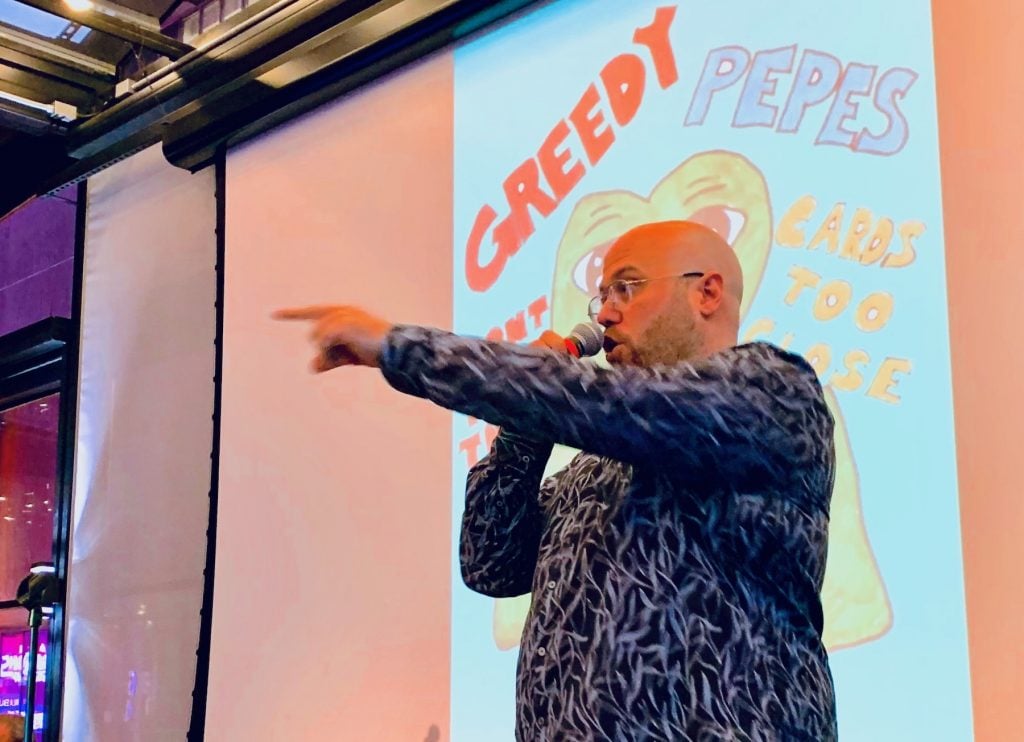
In the third part of a series, we go to an auction of Rare Pepes.

Ben Davis

This article is the third of a series about NFT.NYC and the culture surrounding NFTs. Read Part 1, Part 2, and Part 4 here.
Throughout the NFT.NYC conference, I will hear many sincere testimonials about how NFTs saved someone’s life. People speak about searching for meaning or direction, and finding it in the NFT scene. The vibe during the event can quickly morph from trade show to Comic-Con to tent revival.
Will Gains, a boyish and performatively positive type who emcees part of Day 2, testifies about being a drug addict and having “gambled away seven figures on crypto”—but feeling grateful for the NFT scene for offering him a second chance. “We have one time and one time only to create generational wealth for our families!” Gains exhorts the crowd.
In her presentation, a woman named Alyze Sam, wearing a Bitcoin ball cap and a shirt that says “Alyze in NFTLand,” recounts her story: “I was a hospice nurse. I killed people for 13 years.” Then she found NFTs. “CryptoKitties is life,” she says. She goes on to declare NFTs “the most significant artistic development since the Renaissance.”
A panel on “3-D NFTs” is moderated by Jacob Marko, the NFT Gorilla. He is wearing a gorilla suit and hauls a broken toilet with him wherever he goes. His story is less dramatic, more of a tale of Great Resignation–era reinvention: “I think the world has gone kind of bonkers,” Marko says, mentioning the recent revelations about UFOs and the soaring market in DogeCoin, a cryptocurrency based on a dog meme. “I figured there’s no point in doing cookie-cutter jobs. I’m just going to go on fun adventures.”
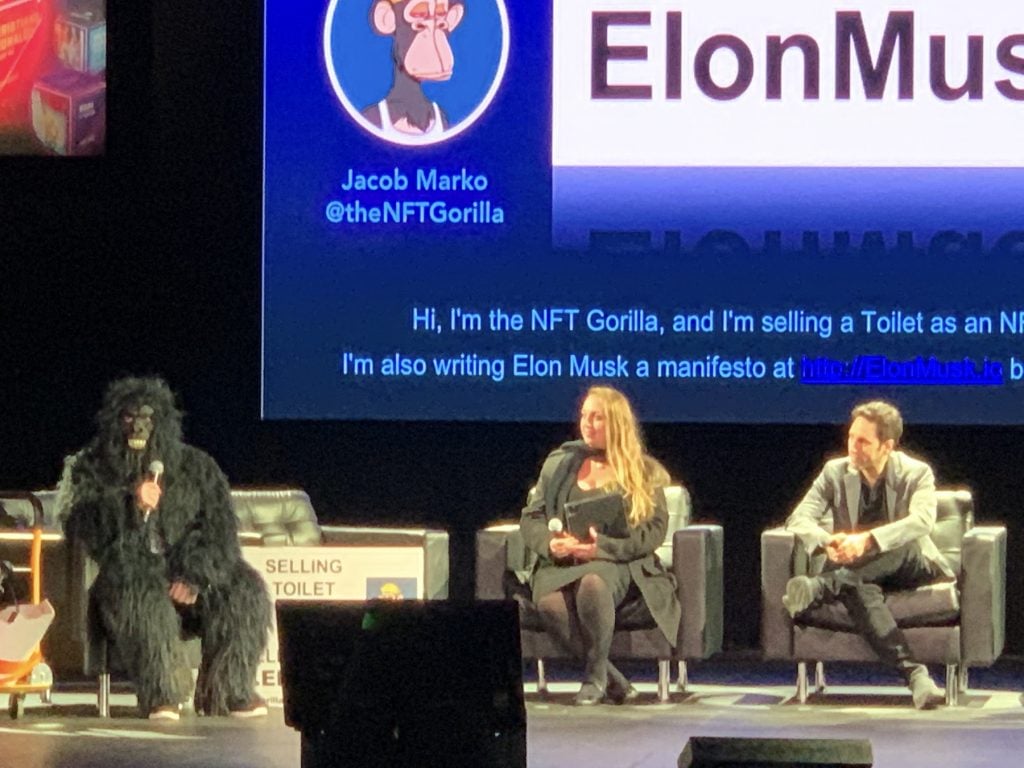
Jacob Marko, the NFT Gorilla, speaks at NFT.NYC. Photo: Ben Davis.
Marko hopes he can sell his “3-D NFT” to Elon Musk, and appeals to the audience to connect the two of them. Recently he fell down and broke his toilet, but “if Banksy has taught us anything, it’s worth more now,” he jokes. But, he hastens to clarify: “I’m not selling the toilet. I’m selling the NFT of the toilet.”
A combination of disillusion with America’s crapshoot economy and a hope—sometimes sincere, sometimes defensively ironic—of riding this technological wave to Elysium, flutters in the conference’s air.
Much more serious is Marjan Moghaddam, who appears on a panel about digital arts. She has decades of digital art under her belt and has spent years making inventive “art hacks,” inserting psychedelic guerrilla AR sculptures into art fairs—an almost perfect symbol of how the commercial art world and digital art have seemed to operate in parallel worlds. Only now is digital art getting the financial heft to match its cultural reach. “We’re living in an era where the next art movement will not be geo-located,” she predicts. “The legacy art world is completely caught up in traditional practices of curation.”
And with the advent of this new kind of digital-art scene, Moghaddam says, she has found “the community and the tribe I have been looking for all my life.” Indeed, “community” is among the most-used words at the conference. The sense of openness, optimism, and purpose is part of what draws people in.
But Moghaddam is also a veteran who’s been through the lean years as well as the fat ones. I feel like I detect a note of doubt about how much of the audience that has showed up for this particular party is actually going to stick around, long term. By the end of her time on stage, the idea of “community” shifts subtly, from something discovered to something that you work to maintain.
Asked what advice she has for young artists, Moghaddam says, “Build an online community. When the crypto wave fades, you will still have something to fall back on.”
William Entriken is a technologist—he claims “lead author” status on the famed ERC-721 standard that enables most NFTs—and a boudoir photographer. He takes the stage on Day 2 for a presentation titled “Vision for NFTs: Year 4 of 10.” He throws up a slide featuring portraits of four Renaissance painters.
“Who are these artists?” he asks the crowd to scattered mutterings. They are, of course, Leonardo, Michelangelo, Donatello, and Raphael—the Italian Renaissance by way of the Teenage Mutant Ninja Turtles.
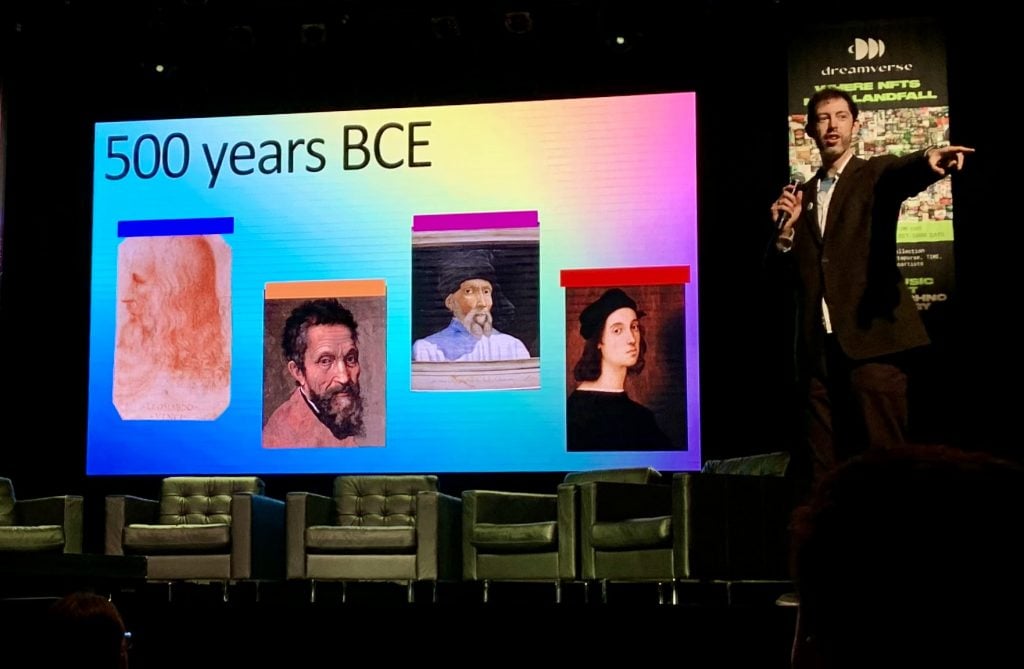
William Entriken speaks on Day 2 of NFT.NYC. Photo: Ben Davis.
“How many of these artists died poor?” Entriken asks the crowd. “All of them,” someone from the crowd says.
Entriken will then declare that “2021 is the year that artists stopped dying poor!”
Not to make too big a deal of this—it’s not the worst crime against art history here, and the general point about the injustices artists have historically faced stands—but Leonardo died employed by the King of France, supposedly with his head in the king’s lap; etc. This is not a big gotcha, just a handy symbol of how so much that is promised here is based on mystification and sound bites.
For the real dynamics at play, you have to stick around for the business talks, which far outnumber the art talks anyway.
Richard Chen, general partner at the analytics firm 1Confirmation, offers a presentation that, in its wonkish way, is a deflation of the utopian claims for the NFT economy. Although NFTs offer a “complete new business model for digital artists” and crypto-art became a $1 billion asset class in early October, Chen shows that there is a “huge power law” at play in the NFT market.
The power law is a distribution found, generally, in winner-take-all markets, where early success begets more success, so that opportunities disproportionally concentrate around an extreme minority. It is the opposite of the we’re-all-gonna-make-it economy.
In practice, that means that “the top 32 artists have more than half of the entire crypto market,” according to Chen. This is important to me, because it is the power law distribution that also characterizes the inequalities of the “traditional” art world that everyone thinks they are escaping, with its cutthroat concentrations of value around “blue-chip” artists. (I have written before about the power law in relationship to art schools, where just a handful of top-tier institutions—Yale, Columbia, CalArts—overwhelm all others as gateways to success.)
Chen’s data, in other words, confirms that in just a few months of its mainstreaming, the NFT space has come to conform to all the hyper-asymmetrical dynamics you’d expect. As one study by Massimo Franceschet and Sparrow Read put it recently: “It turns out that the crypto market is extremely concentrated among few artists and even fewer collectors: if crypto art were a country and sales the income of people, it would be much more concentrated than any other country at any other time in history!”
After “community,” the second-most-used word at NFT.NYC is probably “rich.” As in, “Do you want to be rich?” The speakers ask the audience variations on that question a lot.
“They want to make money out of this talk,” burly, exuberant Karthik Iyer, of the P2P Foundation, reminds his co-panelist on a talk supposedly dedicated to NFT curation. Turning to the crowd, Iyer calls out, “How many people here want to retire in the next three years?” (He will go on to recommend that everyone invest their savings in the booming market for real estate within online worlds.)
Another talk is called, simply, “I’m Rich?” It’s by an artist named Ken Erwin, who created PixelMap, a very early blockchain-enabled project that allowed people to buy bits of a webpage. As interest in collecting early NFTs has surged, Erwin suddenly found himself sitting on a huge asset. His talk is an account of what it was like to discover that he had become an overnight NFT millionaire.
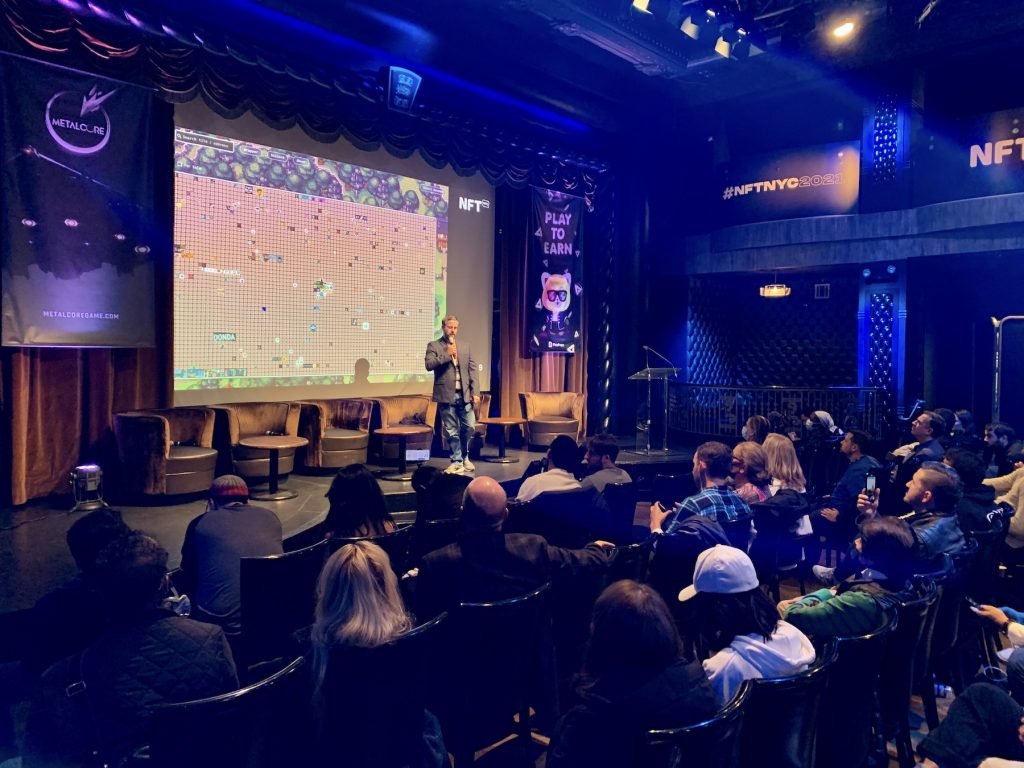
Ken Erwin speaks in his talk “I’m Rich?” at NFT.NYC. Photo: Ben Davis.
At the end, Erwin suddenly assumes a sober tone. He reminds his audience of how important it is to stay grounded, even in the face of crypto riches. “No amount of money can change your happiness,” he says. He then concludes by announcing that he has purchased a Porsche 911 Turbo S.
This presentation takes place at the Edison Ballroom, where programming is more focused on money-making, and talk after talk has a title like “NFTs in Your Investment Portfolio,” “Solving Price Discovery and Liquidity For NFTs,” and “Asset-Backed NFTs as Bearer Instruments.” People comment—often and enthusiastically—that NFTs are superior to old-fashioned art because they are easier to flip in real time, with no physical object to slow you down. People talk about how to increase “loan penetration” of the crypto-art space, about potential new forms of financialization of digital art assets, about the enticing possibility of NFT derivatives.
At one point, in a presentation called “The Master Formula for NFT Value,” Justin Herzig, of something called Own the Moment NFT, unveils what he presents as the literal “formula for success” in NFT investing. It is this: “Speculative Value * (Aesthetic Value + Utility) = NFT Value.”
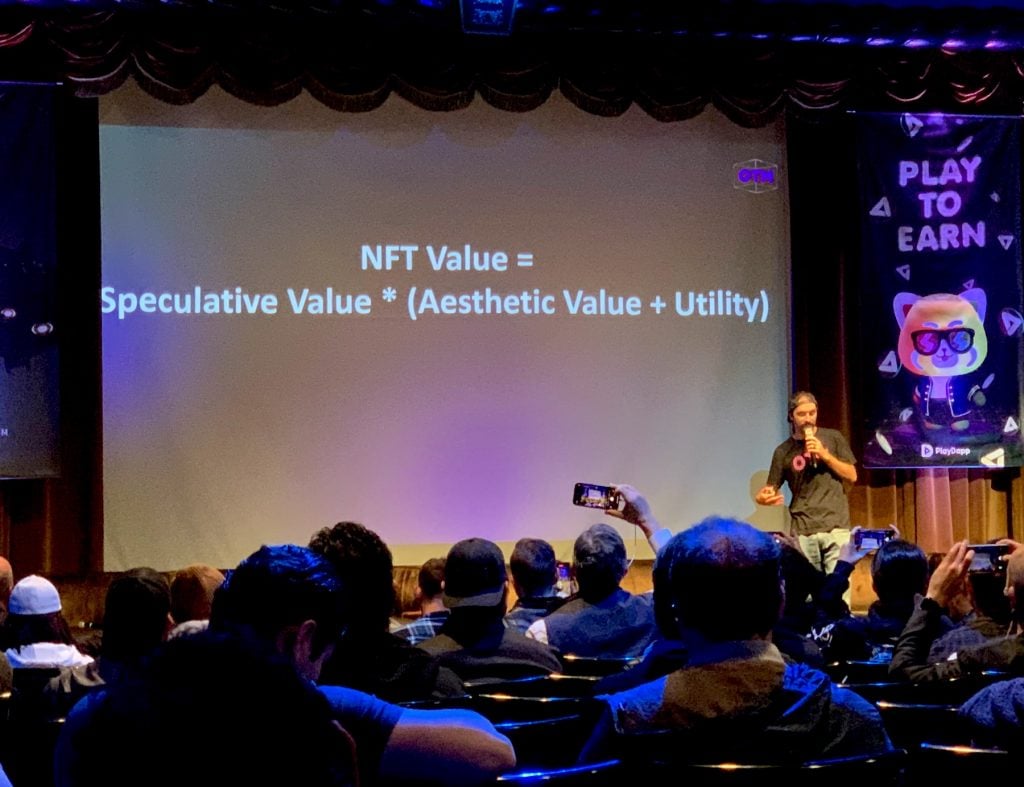
Justin Herzig explains how to invest in NFTs. Photo: Ben Davis.
It is quite clear what the key variable is. “If you have no speculative value, you’re not going to see any value for that project,” Herzig admonishes his audience of would-be NFT investors.
General murmurs of approval. Phones go up to document the formula.
I am at the Edison Ballroom because I am being interviewed for a Vice documentary about art speculation, an appointment which leads me, at the close of Day Two, to an evening auction that marks the debut of a luxe new online NFT marketplace, Mint Gold Dust, an initiative of Kelly LeValley Hunt, a VC and one of the emcees of the previous day.
Guests swarm in from the conference, and paddles appear in the crowd as bidders register. Alcohol and hors d’oeuvres circulate plenteously in the slightly overlit party space, as a live band plays. Auction lots are shown on large flatscreens. Among the crowd, I spot the presence of MetaKovan (a.k.a. Vignesh Sundaresan), the Singapore-based NFT investor who bought Beeple’s Everydays, and his spokesman Twobadour. The latter is sporting a jacket advertising B.20, a project they have launched selling fractionalized ownership stakes in a cache of Beeple’s art.
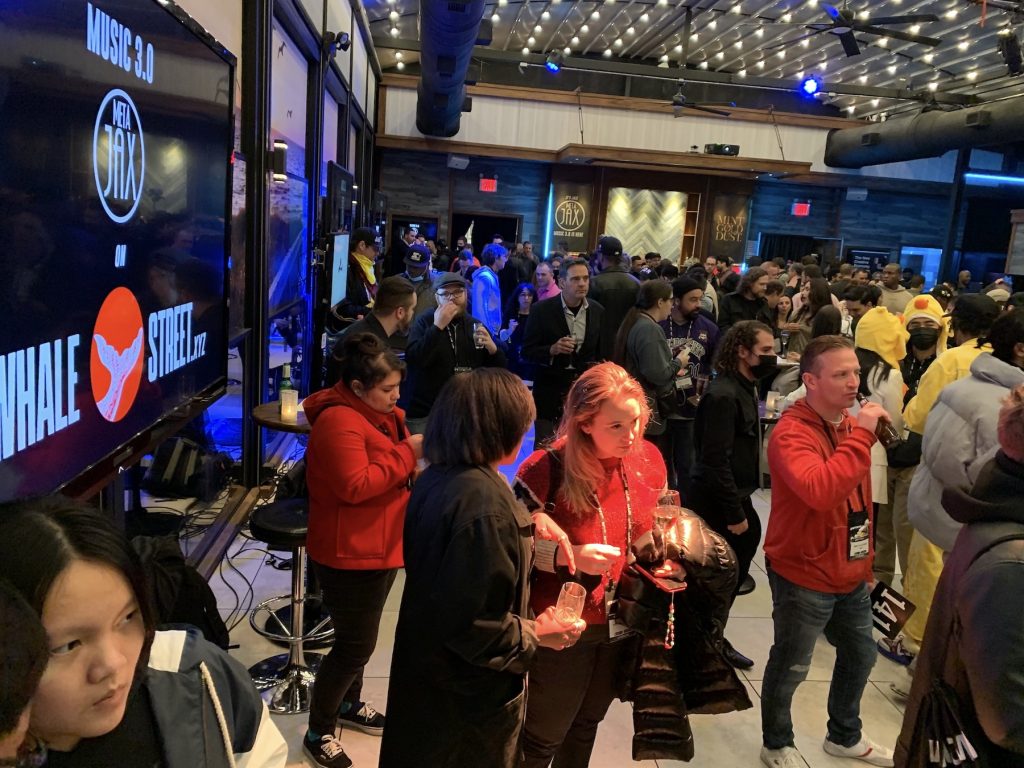
The crowd at the Mint Gold Dust auction. Photo: Ben Davis.
After the crowd has had a chance to get lubricated, our emcee takes the stage to welcome guests and introduce Mint Gold Dust. “We are making history!” she declares, before offering a cry of “Thank you, Satoshi Nakamoto!”, referring to the legendary author of the original white paper that theorized Bitcoin.
The star lots of this auction are “Rare Pepes,” that is, trading-card-like, NFTed versions of memes featuring Pepe the Frog. Issued in 2016 and 2017, this is a historic project: On October 26, a Rare Pepe had sold for $3.6 million at Sotheby’s (the auction house explains on its website that the series “contains some of the rarest NFTs known to pepekind,” a description designed to tickle the faithful and confound the unconverted).
Tonight’s Lot 4, for instance, is Bad Odor Pepe, a droopy-eyed frog-man, holding a bag containing some kind of moist load, flies buzzing all around. “I think everyone can relate to this Rare Pepe,” auctioneer Theo Goodman says. “Does anyone have a bag of something smelly in your portfolio? Maybe someone bought some profile pic NFTs that are not doing so great? This one’s for you.” It will sell for $5,000.
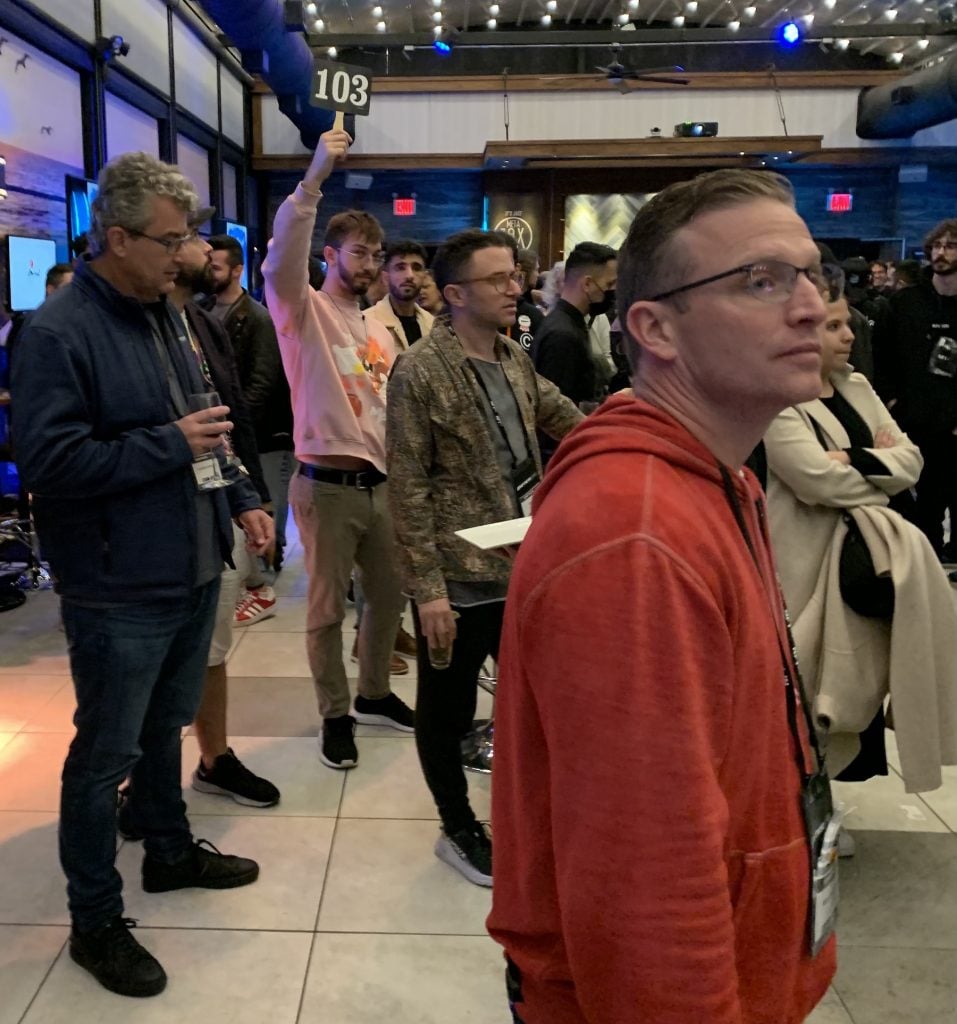
A bidder during the Mint Gold Dust auction. Photo: Ben Davis.
As Goodman stares out from the stage, spotting the bids percolating in the crowd, I think about how last year I interviewed the directors of Feels Good, Man, a very good documentary about the history of the Pepe the Frog meme. It traces Pepe from the character’s emergence in San Francisco artist Matt Furie’s indie comic “Boy’s Club” to its incorporation into online slacker culture to its transmogrification by 8chan into an icon of hate, as trolls flooded the internet with bigoted and pornographic Pepes. It became a culture wars symbol, and during the 2016 election, Hillary Clinton herself even denounced Pepe, her campaign going so far as to release an anti-Pepe explainer.
Feels Good, Man does mention the “Rare Pepes” phenomenon, showing one investor, Peter Kell, buying a Homer Simpson/Pepe NFT at auction and flouting his crypto-riches for the cameras in a Lamborghini (the car was actually rented for the purposes of the film as a fake-it-til-you-make-it flex). But this is a tangent from the documentary’s primary narrative, which is Furie’s quest to take back Pepe, to wrest it from its association with the online alt-right.
And the consensus in the doc—which came out only a year ago!—was that cleansing the symbol of its negative associations was a quixotic, probably impossible task. A group of computer experts in the film, after doing a mass of data analysis, tell Furie that there are untold thousands of right-wing memes out there, almost all of which prominently promote a Pepe-fied version. Almost everyone interviewed in the film seemed to think that Pepe the Frog would be remembered first of all as an icon of evil.
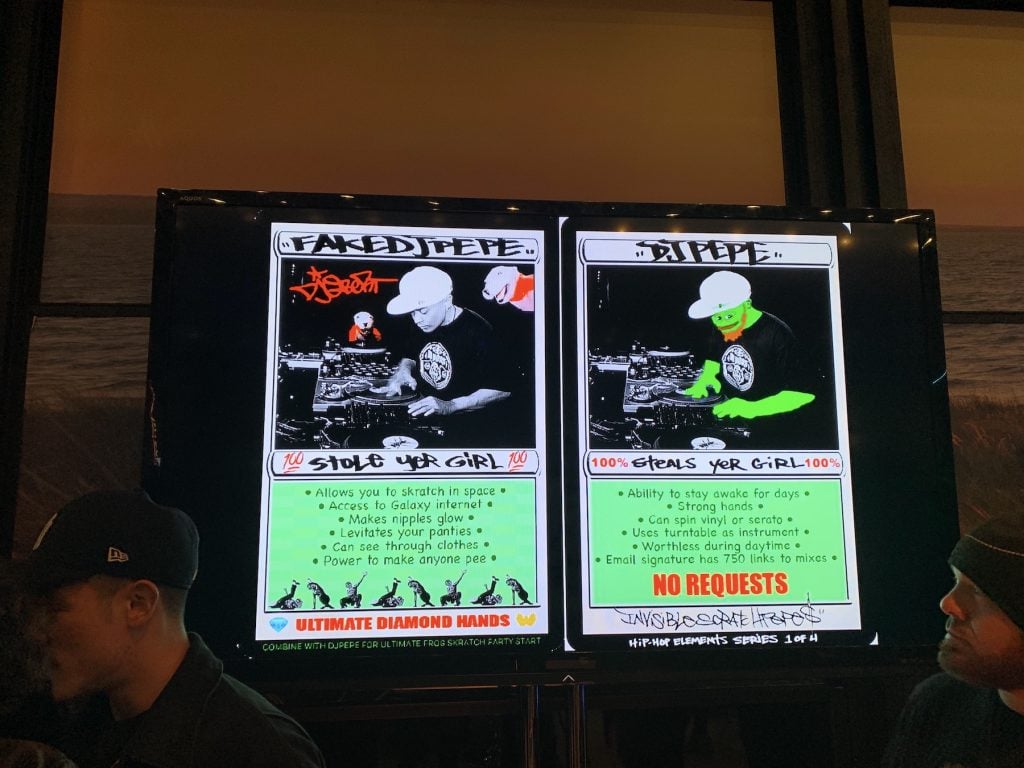
Lot for the Mint Gold Dust Rare Pepes auction on view. Photo by Ben Davis.
But here in the boom time of NFT Land in 2021, the negative association doesn’t even merit a dismissal. Pepe not only is not taboo, but a status symbol of the first order. In just the few short months of the NFT explosion, the influx of hot money has already totally changed the rules of internet culture, rewriting the pathways of discourse and desire in a way that nothing else could (Matt Furie himself has benefited, selling his own line of Pepe NFTs). Or so it seems.
Still, the action at the Edison Ballroom Rooftop is mainly modest, often in the thousands. Not everything sells. Some Pepe teacups are auctioned, without a reserve price, for $700. Goodman keeps stopping to coax the crowd, and remind them they are rich: “Ethereum is at an all-time high!”
By a long ways, the biggest lot of the Mint Gold Dust sale is a “Pepe Nakamoto.” The image features a green-skinned rendering of the (imagined) features of the supposed Bitcoin creator, Satoshi Nakamoto. The starting bid for this image is half a million dollars.
By now, MetaKovan and Twobadour have positioned themselves at the front, as if waiting, directly at the center of the auctioneer’s gaze. The crowd continues to chatter, distractedly.
“Anyone gonna bid $500,000 on this?” Goodman asks. “Any big spenders out there? Where ya’ll whales? Any big spenders now?” No bids for the Nakamoto. “You all talk a big game… Come on now… You talk all this shit… Come on now… You come to this conference in Lambos… Come on…”
Goodman spins on for agonizing seconds like this in front of an inert audience. And he is about to let the lot pass—when, at last, MetaKovan makes his move. He raises his paddle, with a deadpan lack of flourish, as if it’s not the biggest thing to happen this evening.
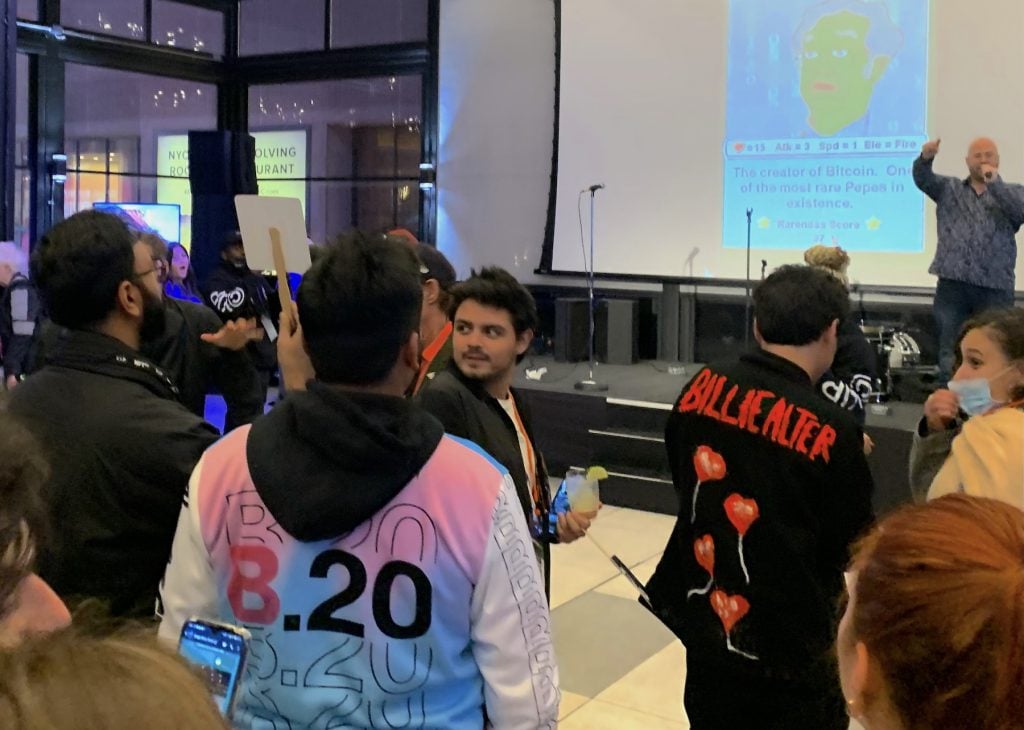
MetaKovan wins the top Rare Pepe at the Mint Gold Dust in-person auction. Photo: Ben Davis.
“$500,000!” Goodman exclaims. A burst of applause from the audience.
“Anyone gonna bid $501?… Going once… Anyone gonna give me $501?… Going twice… Fair warning…”
No further bids are forthcoming.
“Sold!” Goodman declares. “$500,000.” The winning paddle number is 69.